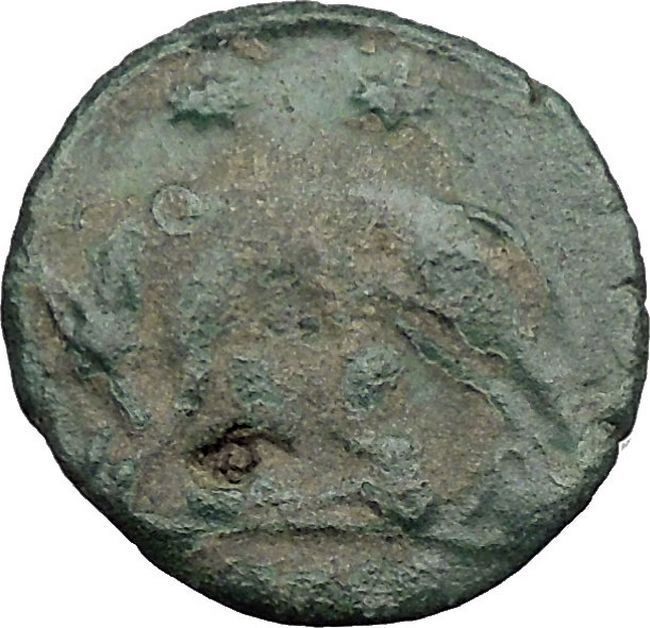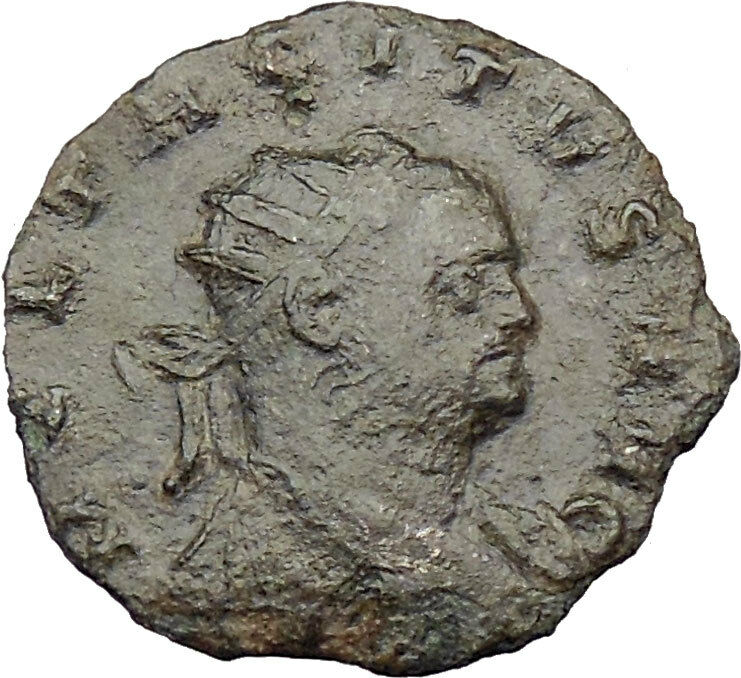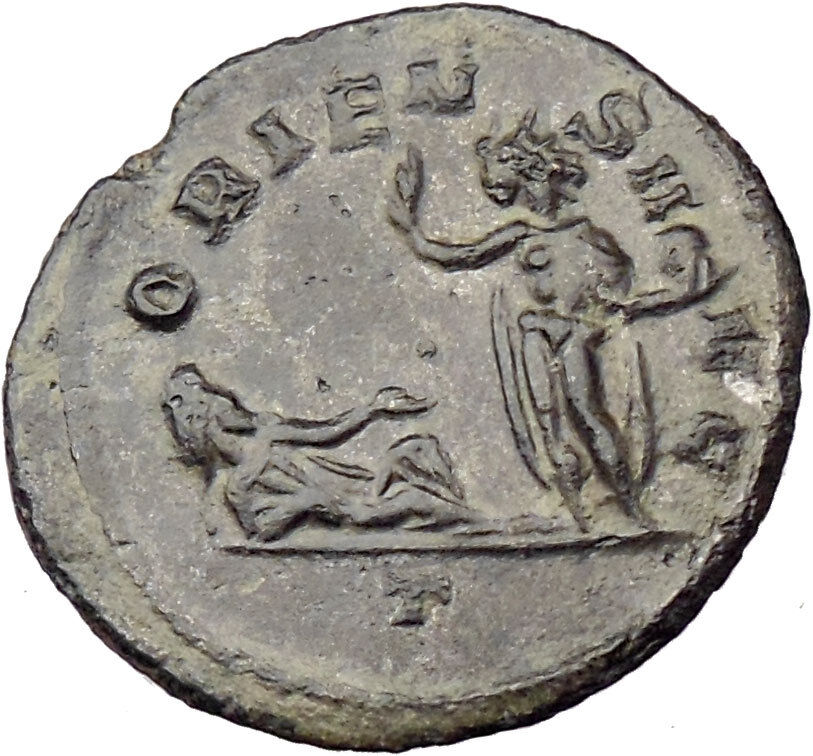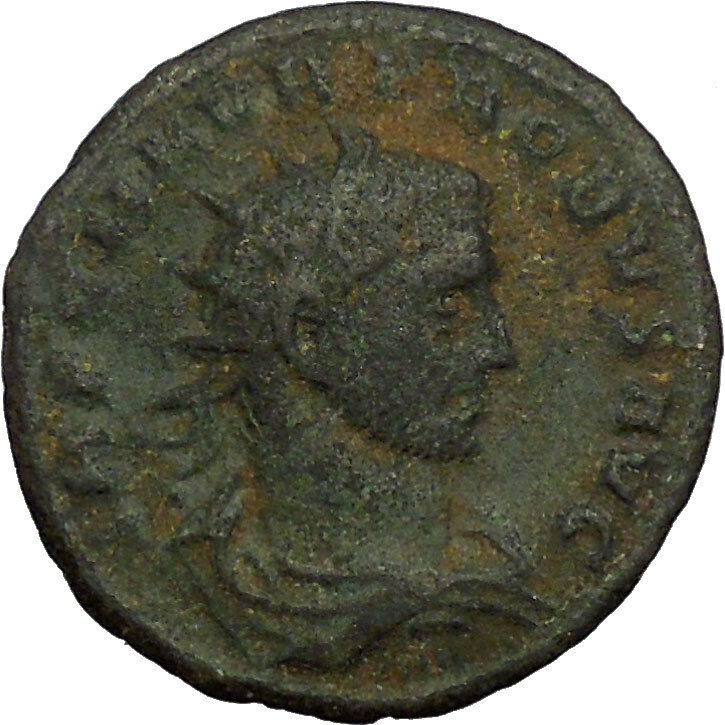|
Caracalla
–
Roman Emperor
: 198-217 A.D. –
Silver Denarius 19mm (3.43 grams) Rome mint: 201-206 A.D.
Reference: RIC 144b, C 658
ANTONINVSPIVSAVG – Laureate, draped bust right.
VICTPARTMAX – Victory advancing left, holding wreath and palm.
You are bidding on the exact item pictured,
provided with a Certificate of Authenticity and Lifetime Guarantee of
Authenticity.

In
ancient Roman religion
, Victoria was the
personified
goddess of victory. She is the
Roman equivalent
of the
Greek goddess
Nike
, and was associated with
Bellona
. She was adapted from the
Sabine
agricultural goddess
Vacuna
and had a
temple
on the
Palatine Hill
. The goddess
Vica Pota
was also sometimes identified with
Victoria.
Unlike the Greek
Nike
, the goddess Victoria (Latin
for “victory”) was a major part of Roman society. Multiple temples were erected
in her honor. When her statue was removed in 382 CE by Emperor
Gratianus
there was much anger in Rome. She was
normally worshiped by
triumphant
generals returning from war.
Also unlike the Greek Nike, who was known for success in athletic games such
as
chariot races
, Victoria was a symbol of victory
over death and determined who would be successful during war.
Victoria appears widely on Roman coins, jewelry, architecture, and other
arts. She is often seen with or in a
chariot
, as in the late 18th-century sculpture
representing Victory in a
quadriga
on the
Brandenburg Gate
in
Berlin
, Germany; “Il Vittoriano”
in Rome has two.
Winged figures, very often in pairs, representing victory and referred to as
“victories”, were common in Roman official iconography, typically hovering high
in a composition, and often filling spaces in
spandrels
or other gaps in architecture. These
represent the spirit of victory rather than the goddess herself. They continued
to appear after Christianization of the Empire, and slowly mutated into
Christian angels
.
Antoninus (Called ‘Caracalla’)
 Caesar: Caesar:
195-198 A.D.
Augustus: 198-217 A.D.
( 198-209 A.D. – with Septimius Severus)
( 209-211 A.D. – with Septimius Severus and Geta)
( 211-217 A.D. – Sole Reign)
Caracalla (April
4, 188
–
April 8
,
217.
Caracallus ), born Lucius Septimius Bassianus and later called Marcus
Aurelius Antoninus and Marcus Aurelius Severus Antoninus, was the
eldest son of
Septimius Severus
and
Roman Emperor
from 211 to 217. He was one of
the most nefarious of Roman emperors. Caracalla’s reign was notable for:
-
the
Constitutio Antoniniana
, granting
Roman citizenship
to freemen throughout the
Roman Empire
, according to
Cassius Dio
in order to increase taxation;
-
debasing the silver content in Roman coinage by 25 percent in
order to pay the legions; and
-
the construction of a large
thermae
outside Rome, the remains of which, known as the
Baths of Caracalla
, can still be seen today
“Caracalla was the common enemy of all mankind,” wrote
Edward Gibbon
. He spent his reign traveling
from province to province so that each could experience his “rapine and
cruelty.”
Caracalla’s real name was Marcus Aurelius Antoninus. He got the
nickname from his habit of wearing a cloak by the same name. Caracalla was the
elder son of Septimius Severus and brother of Geta whom he positively hated.
Hated so much, in fact, that he had him murdered a few years later. In the
mayhem that followed, Caracalla’s men went on a killing spree of anyone
suspected of being a Geta sympathizer. In the massacre, it’s estimated up to
20,000 people lost their lives. Caracalla would go on to rule for another five
years but his bad karma caught up with him and he was assassinated in a plot
perpetrated by Macrinus.
As an emperor Caracalla possessed few redeeming qualities and among the worst
of them would be his ruinous drain on the treasury. Because he knew everyone
hated him he sought the protection of the army. And the surest way of getting
this protection was to buy it outright. He raised the pay of the solider to
about four denarii per day, nearly quadrupling the salary of just a few years
prior. And on top of their regular salary he heaped endless bonuses and other
concessions meant to endear them. This money could only have come by the
oppressive taxation of ordinary citizens as well as the seizures of property of
the wealthy under trumped-up charges. This not only intensified the hatred
against him but also had the effect of corrupting the military who had become
accustomed to this life of luxury and throwing the economy into lasting
disarray.
Rise to power
Caracalla, of mixed
Punic
/Berber
and Syrian
Arab
descent, was born Lucius Septimius Bassianus in
Lugdunum
,
Gaul (now
Lyon,
France
), the
son of the later Emperor Septimius Severus and
Julia
Domna
. At the age of seven, his name was changed to Marcus Aurelius
Septimius Bassianus Antoninus to solidify connection to the family of
Marcus Aurelius
. He was later given the
Caracalla nickname
, which referred to the Gallic hooded tunic he habitually wore
and which he made fashionable.
His father, who had taken the imperial throne in 193, died in
211 while touring the northern marches at
Eboracum
(York),
and Caracalla was proclaimed co-emperor with his brother
Publius Septimius Antoninius Geta
. However since both of them wanted to be
the sole ruler, tensions between the brothers were evident in the few months
they ruled the empire together (they even considered dividing the empire in two,
but were persuaded not to do so by their mother). In December 211, Caracalla had
Geta, the family of his former father-in-law
Gaius Fulvius Plautianus
, his wife
Fulvia Plautilla
(also his paternal second cousin), and her brother
assassinated. He persecuted Geta’s supporters and ordered a
damnatio memoriae
by the Senate against his brother.
Reign
In 213 Caracalla went north to the German frontier to deal
with the
Alamanni
who were causing trouble in the
Agri Decumates
. The emperor managed to win the sympathy of the soldiers with
generous pay rises and popular gestures, like marching on foot among the
ordinary soldiers, eating the same food, and even grinding his own flour with
them.
Caracalla defeated the Alamanni in a battle near the river
Main, but failed to
win a decisive victory over them. After a peace agreement was brokered, the
senate conferred upon him the title “Germanicus Maximus”. In the next year the
emperor traveled to the East.
When the inhabitants of
Alexandria
heard Caracalla’s claims that he had killed Geta in self-defense,
they produced a satire mocking this claim, as well as Caracalla’s other
pretensions. Caracalla responded to this insult savagely in 215 by slaughtering
the deputation of leading citizens who had unsuspectingly assembled before the
city to greet his arrival, and then unleashed his troops for several days of
looting and plunder in Alexandria. According to historian Cassius Dio, over
20,000 people were killed.
During his reign as emperor, Caracalla raised the annual pay
of an average legionary to 675
denarii
and lavished many benefits on the army which he both feared and
admired, as instructed by his father Septimius Severus who had told him to
always mind the soldiers and ignore everyone else. His official portraiture
marked a break with the detached images of the philosopher-emperors who preceded
him: his close-cropped haircut is that of a soldier, his pugnacious scowl a
realistic and threatening presence. The rugged soldier-emperor iconic type was
adopted by several of the following emperors who depended on the support of the
legions, like
Trebonianus Gallus
.[11]
Seeking to secure his own legacy, Caracalla also commissioned
one of Rome’s last major architectural achievements, the
Baths of Caracalla
, the largest public bath ever built in ancient Rome. The
main room of the baths was larger than
St. Peter’s Basilica
, and could easily accommodate over 2,000 Roman citizens
at one time. The bath house opened in 216, complete with private rooms and
outdoor tracks. Internally it was decorated with golden trim and mosaics.

The Roman Empire and its provinces in 210 AD
Fall
While travelling from
Edessa
to begin a war with
Parthia
, he
was assassinated while urinating at a roadside near
Harran
on
April 8
,
217 by Julius
Martialis, an officer in the imperial bodyguard.
Herodian
says that Martialis’ brother had been executed a few days earlier by Caracalla
on an unproven charge; Cassius Dio, on the other hand, says that Martialis was
resentful at not being promoted to the rank of centurion. The escort of the
emperor gave him privacy to relieve himself, and Martialis ran forward and
killed Caracalla with a single sword stroke. He immediately fled on horseback,
but was killed by a bodyguard archer.[
neededcitation]
Caracalla was succeeded by the Praetorian Prefect of the
Guard,
Macrinus
,
who almost certainly was part of the conspiracy against the emperor.
His nickname
According to
Aurelius Victor
in his Epitome de Caesaribus, the
cognomen
“Caracalla” refers to a Gallic cloak
that Caracalla adopted as a personal fashion, which spread to his army
and his court.
Cassius Dio
and the
Historia Augusta
[14]
agree that his nickname derived from his cloak, but do not mention its country
of origin.

Caracalla and Geta by
Lawrence Alma-Tadema
. 1907.
Legendary king of Britain
Geoffrey of Monmouth
‘s legendary
History of the Kings of Britain
makes Caracalla a king of Britain,
referring to him by his actual name “Bassianus”, rather than the nickname
Caracalla. After Severus’s death, the Romans wanted to make Geta king of
Britain, but the Britons preferred Bassianus because he had a British mother.
The two brothers fought a battle in which Geta was killed, and Bassianus
succeeded to the throne. He ruled until he was betrayed by his
Pictish
allies
and overthrown by
Carausius
,
who, according to Geoffrey, was a Briton, rather than the
Menapian
Gaul
that he actually was.
|






 Caesar:
Caesar:




